Badagoni
by
Kathy & Terry Sullivan
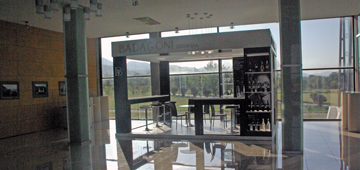 Summary: Badagoni winery, one of George’s largest wineries, was named for the ancient Georgian god of wine. The winery also owns four hundred hectares of vineyards.
Summary: Badagoni winery, one of George’s largest wineries, was named for the ancient Georgian god of wine. The winery also owns four hundred hectares of vineyards.
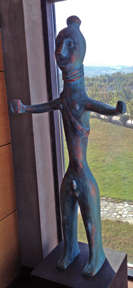 The name Badagoni is from ancient Georgia and is the name of the god of wine and winemaking. A statue of Badagoni was discovered in Georgia dating to the 7th century BC. A replica of the statue is on display in the glass-enclosed entrance of the winery.
The name Badagoni is from ancient Georgia and is the name of the god of wine and winemaking. A statue of Badagoni was discovered in Georgia dating to the 7th century BC. A replica of the statue is on display in the glass-enclosed entrance of the winery.
Badagoni was founded in 2002 and by 2006 opened one of the most technologically advanced wineries in Georgia. Three friends who started the winery decided to build the winery in Zemo Khodashen because they liked the view and they liked wine. From the balcony visitors can view the Caucasus Mountains. The group found a partner in Italy to help them fulfill their dream. The owners decided to start the winery and produce quality wines for the European market. Today, Badagoni exports wines to Poland, Ukraine, Italy, China and Russia.
Badagoni winery produces 4,000,000 bottles of wine. In order to produce this they use their 400 hectares (988 acres) of vineyards mostly in the Kakheti region and source grapes from other Georgian grape growers. The vineyards include white varieties such as Mtsvane, Rkatsiteli and red varieties including Aleksandrouli, Mujurentuli and Saperavi. The Aleksandrouli and Mujurentuli grapes are grown in the Racha-Lechkhumi region of Western Georgia.
As one of the largest producers in Georgia, Badagoni produces both qvevri and European-style wines. Qvevri wines are racked to a second qvevri. Tannins protect the qvevri wines. At Badagoni sulfur is added to protect the wine from oxidation.
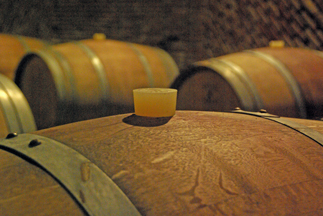 Winery Facility
Winery Facility
The winery uses oak barrels from France constructed with French and American oak. The barrel room has subdued lighting and barrels are not stacked. The walls are made of brick showing different designs. Stainless steel tanks fill an area next to presses.
On the day of our visit, a van delivered drums filled with Saperavi grapes. After weighing the grapes, the van backed to a hopper where the grapes were emptied and destemmed.
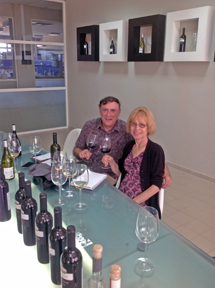 White Wines
White Wines
We tasted several Badagoni wines in an elegant tasting room near the winery’s extensive very clean laboratory. We sat at a large, unusual table. At each place setting, a stainless steel drawer slides open and functions as a dump bucket with running water. The trickling of water could be heard in the background while we tasted and discussed the wines. The smoky glass table is lit from underneath providing excellent viewing of a wine’s color. Some of the wine bottles had a tear-off label. On the Alaverdi Tradition dry white qvevri wine, the tear-off label was a short pamphlet about Badagoni and Alaverdi Monastery.
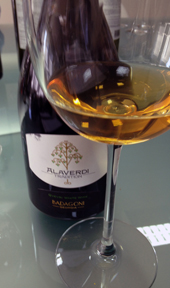 Kakhetian Noble 2010 was a blend of Rkatsiteli and Mtsvane. This limited production European-style wine was a light yellow. Notes included apple, pear and a touch of citrus. Alaverdi 2011 Traditional wine was produced with Rkatsiteli. This wine was made in partnership with Alaverdi Monastery. The wine was a dark gold. The wine was aged in qvevri for five to six months on its chacha (pomace.) The wine offered floral nuances and tannins. Tvishi 2010 Appellation Controlled was made with the Tsolikauri grapes and was a straw color. The aroma was sweet with floral and yellow stone fruit nuances. The taste reminded one of peach, nectarine and minerality. The finish was fruity.
Kakhetian Noble 2010 was a blend of Rkatsiteli and Mtsvane. This limited production European-style wine was a light yellow. Notes included apple, pear and a touch of citrus. Alaverdi 2011 Traditional wine was produced with Rkatsiteli. This wine was made in partnership with Alaverdi Monastery. The wine was a dark gold. The wine was aged in qvevri for five to six months on its chacha (pomace.) The wine offered floral nuances and tannins. Tvishi 2010 Appellation Controlled was made with the Tsolikauri grapes and was a straw color. The aroma was sweet with floral and yellow stone fruit nuances. The taste reminded one of peach, nectarine and minerality. The finish was fruity.
Red Wines
Kakhetian Noble 2010 was produced with Saperavi specially selected grapes. The wine was a dark ruby with dark fruit aroma notes. The taste offered blackberry and plum nuances. The finish had bold tannins. Alaverdi Tradition 2007 was produced at the Alaverdi Monastery. The dark ruby wine offered dark fruits and spices. The taste was of blackberries and cassis. Tannins were on the finish. Mukuzani 2010 Appellation Controlled was produced with Saperavi. This dark ruby wine offered an aroma of dark fruit. The taste had notes of blackberries with a hint of plums. The fruity finish had tannins.
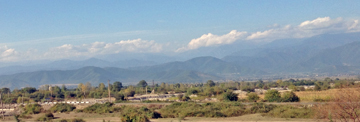 Although the building we tasted wines in is modern, it blends well into the environment.
Although the building we tasted wines in is modern, it blends well into the environment.
With such a large production, we hope to see Badagoni wines exported to other countries including the United States.
Badagoni
Zemo Khodasheni, Kakheti, Georgia
